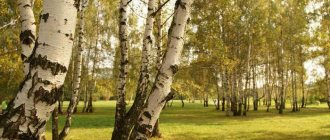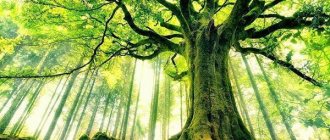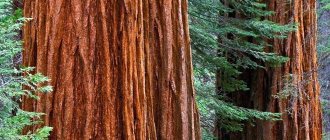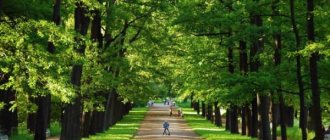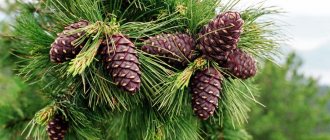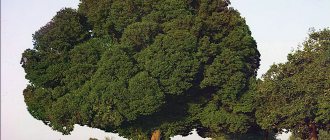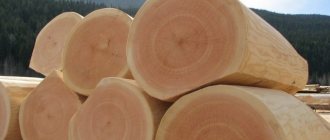Even in children's fairy tales, the expression “hundred-year-old oak” is often found. This particular tree seems to be a classic long-liver. Of course, the life of an oak tree is far from limited to a century, but this is far from a record figure. Moreover, trees that are close and familiar to us can also live for a very, very long time. In this material we will tell you how many years these plants live, and who is the record holder.
♥ ON TOPIC: Why birds are not electrocuted on wires.
How many years does a birch tree live?
Birch has long been considered the most favorite tree of poets, artists and ordinary people. They wrote poems about it, sang songs, painted it, and used it in medicine. This is a beautiful tree with interesting colors, tasty sap and medicinal pollen. Throughout its life, people use healing branches, leaves, buds, and bark. It seems to people that the birch tree lives forever.
Birch. Types and lifespan
There are about 120 species of birch, 64 species are found in the forests of Russia. The average lifespan of a birch is about one hundred years and depends on living conditions. In principle, this is an unpretentious tree that can live well in any soil. The main thing is that the soil is moist, since birch loves water and consumes up to 250 liters per day.
In Russian forests, birches live no more than 120 years, with the exception of iron birch, whose lifespan is almost 400 years.
Just 100 years ago, birch was a rarer tree than it is now. It grew mainly along river banks and in forests where coniferous trees had fallen. So she grew up in different places of the taiga. For more than 150 years, the birch tree did not stay in one place.
Stone birch grows in the Far East. Its age is 3-4 times greater than white birch and is 500 years old. Its trunk is more like an apple tree, the only difference is in the bark. The color of the bark is neither like a birch nor an apple tree. This is a pink-gray bark that lags behind the tree itself and hangs down in long strips.
Warty birch or silver birch are widespread. She grows quite quickly, starting from the age of 10, she grows by 75-90 cm per year and lives 50-60 years.
Application in medicine
In folk medicine, they use everything that birch can provide. Its juice is an excellent immunostimulating, cleansing and vitamin remedy. Bath brooms are made from branches and leaves, which, under the influence of hot air in the bath, release essential healing oils that have a beneficial effect on the condition of the skin and the entire human body.
Birch buds help well with many diseases, because they contain essential oils, tannins, resins, grape sugar, flavonoids and ascorbic acid. It is a good antiseptic and expectorant that is used to treat diseases of the respiratory system. In addition, they are used in the form of lotions or dressings for various soft tissue wounds.
Birch sap is recommended for use in cases of poisoning and cancer. It perfectly stimulates metabolism, has a diuretic and anthelmintic effect.
These are not all the diseases that birch treats.
Life expectancy of birch: features of growing in a summer cottage
In order to fully experience the beneficial properties of this tree, you can grow it in your summer cottage. The lifespan of a birch tree depends on the characteristics of planting and care. That is, you have the power to extend or, conversely, shorten the life of this slender tree. It is worth noting that birch can be grown from seeds or seedlings.
You will have to tinker with the seeds, because before planting they need to be kept in a cold place for several months and then dried for several days. After this, the seeds are placed in a shallow hole and covered with a layer of humus.
The most interesting thing is that this must be done after the first snow appears on the cold ground, or immediately after the snow melts in early spring. It is necessary that the soil be cold so that the seeds can remain in the ground for a long period of time to harden, as well as swell and grow faster. Seedlings are planted in spring. It is necessary to carefully care for this tree; weeds can interfere with plant growth.
They severely clog the root system, which significantly shortens the life of the tree. It is worth remembering that birch roots are very developed and can drink up to 250 liters of water per day. That is why birch is common near ponds and rivers. In dry forests it is very difficult for her, because there is not enough moisture. It needs frequent and constant watering.
Birch bark
The oldest trees
Pine: what it looks like and how many years it lives, pros and cons
As already mentioned, today there are about 600 species of oaks in the world. Each species is unique, differs in both size and appearance, and most importantly, life expectancy. Of course, it is not possible to list and talk about all types of oak, but it is possible to mention the oldest trees.
Let's get acquainted with long-lived oaks that amaze people with their size and age. It should be noted that some of the oldest trees are still growing and functioning, but others live in legends, tales and stories of our ancestors.
Mamvrian
This is the oldest oak tree known today. Its homeland is the Palestinian Authority in the city of Hebron. Scientists have determined that its age is approximately 5 thousand years.
The history of the Mamre oak dates back deeply to biblical times. There are many biblical stories associated with this giant. It was under this tree that the meeting between Abraham and God took place.
Since this giant is often mentioned in the Bible, people have been looking for it for a long time and wanted to profit from it. In the 19th century, the oak was found by the clergyman Anthony, which belonged to the Russian Orthodox Church. Since then, this miracle of nature has been constantly looked after.
People formed an opinion, which over time began to be called a prophecy. There is such a belief: when the “Mamvrian giant” dies, the apocalypse will come. In 2022, a terrible thing happened - a tree that had been drying out for a long time collapsed.
Stelmuzhsky
The Stelmuz oak grows in Lithuania, its height is 23 meters, its trunk girth is 13.5 meters.
The tree is very old. According to some information, we can conclude that the Stelmuzh oak is about 2 thousand years old. It was often mentioned in ancient pagan manuscripts, where they wrote about how sacrifices were made to the gods near the oak tree, and under its crown an ancient pagan temple was erected for the same sacrifices
Granitsky
The village of Granit, which is located in Bulgaria, is the proud owner of another rarity, known throughout the world. For 17 centuries, an oak called the Giant oak has been growing in the village. The height of the giant is 23.5 meters.
The tree is held in high esteem by local residents. People know the history of the oak well and respect it, because based on historical data it can be concluded that the Giant Oak was a participant in many historically important moments. He is currently alive. The villagers are actively collecting its fruits and acorns and trying to grow young shoots from them, because everyone understands perfectly well that sooner or later the Giant Oak will die.
"Oak Chapel"
Residents of the village of Allouville-Bellefosse, in France, have been the custodians of one of the oldest oak trees in the world, the Chapel Oak, for over a thousand years. The height of the tree is currently 18 meters, the trunk girth is 16 meters. The trunk of the tree is so large that two chapels fit in it - the hermit's and the Mother of God's. They were created by human hands back in the 17th century.
This unusual fact is the reason that a crowd of tourists comes to the tree every year. To get to the chapels, you need to climb a spiral staircase, which is also located in the oak trunk.
"The Hero of Taurida"
Of course, such a beautiful corner of the globe as Crimea, whose nature and flora is amazing, also contains one of the wonders on its territory. “The Bogatyr of Taurida”, a botanical natural monument of the peninsula, has been growing in Simferopol for 700 years.
This oak has an interesting rich history. It is believed that its first shoots appeared at the time when the famous Kebir-Jami mosque was being built. And also we should not forget that it was this long-liver who was mentioned by A.S. Pushkin in his greatest poem “Ruslan and Lyudmila”.
Birch
A primordially Russian beauty, praised in songs, mentioned in proverbs and Russian folk tales. But it grows not only in our vast expanses; you can find birch in American and Chinese forests. The slender tree is easy to recognize by its color: the white bark is crossed by black stripes.
In early spring, when the buds are just beginning to swell on most trees, birch trees are already covered with the first green leaves. In two weeks, the birch forest turns from a gloomy forest into a colorful grove.
How many years does a birch tree live?
Here it is worth noting the fact that it is difficult to reliably answer this question: it is impossible to keep track of the second, tenth or hundredth tree. In addition, birch has many different species and subspecies , each of which has a number of external features and its own life expectancy.
The Karelian birch, known to many, lives for a relatively short time, compared to other trees: only 30-50 years.
But its common “relative”, drooping or warty , is capable of living up to 120. But along with them, there are also centenarians, whose age dates back to the fourth, or even the fifth century.
If we talk about “average” values, they fluctuate around 100–300 years. But this is not the limit: during all this time, the birch tree is diligently developing, stretching in height and growing long branches. And when growth stops, the movement of nutrients in the trunk begins to gradually slow down - in this state the tree can live for more than one year.
Nowadays it is not so often possible to find an oak grove in Russia. But if you happen to visit one, you will immediately realize all the mystery and majesty of these trees. Maybe they don’t sing songs about them, but they make up legends. Oak is the personification of strength, wisdom and longevity.
It grows mainly in
areas located in the northern hemisphere .
Starting its journey as a small and slender tree, over the years the oak acquires its inherent massiveness: the spreading crown can reach 40 meters in height, and the circumference of already “established” trunks is 9 meters, which is also quite a lot. The tree is also known for its healing properties: a decoction of oak bark has good anti-inflammatory properties and is used in folk medicine. And acorns are an excellent component for relieving spasms, swelling and inflammation.
How many years does an oak tree live?
This tree is one of the longest living . And it’s not easy - oak can survive fire and water, reaching up to two thousand years! But it’s worth making a reservation: the average life expectancy of one of the “representatives” of the oak forest ranges from 300 to 450 years. And only under favorable conditions these years can stretch for tens of centuries.
During the first 100-150 years, the oak tree actively develops, blooming only by 20 or even 30 years. But the diameter of its trunk increases throughout its life, becoming overgrown with new layers of bark.
There are two particularly old and therefore remarkable trees on the planet:
- The Mamre oak has been growing in Palestine for almost two thousand years. It is so old that even in the Bible there is a mention of it: once upon a time, it was under this tree that Patriarch Abraham accepted God.
- And in Lithuania you can find the Stelmuzh oak - the oldest tree in all of Europe. If you believe the sources that mention him, he is at least a century older than his sacred “comrade.”
Healing properties of oak
How long does a honey bee live?
Marina Kulikova, Candidate of Biological Sciences
Oak bark has been widely used in medical practice since the beginning of the 19th century as an astringent and anti-inflammatory agent. This effect of oak bark is explained by the presence of tannins in it. Powder from ripe acorns was used in folk medicine for diarrhea and scrofula, and also as a raw material for surrogate coffee.
Nowadays, oak bark is used as an astringent and hemostatic agent in the form of an aqueous decoction for rinsing for gingivitis, stomatitis, and other inflammatory processes in the mouth, throat and larynx. Oak bark is also included in gargling preparations.
The bark of young branches and trunks (before a cracked crust appears on them), which is collected in the spring during the period of active sap flow, is used as a medicinal raw material. Overgrowth shoots are ideal for these purposes.
About 10% tannins, free gallic and ellagic acids, and pectin substances were found in the bark.
Dry the bark in natural conditions under a canopy, in well-ventilated areas, spreading it in one layer on cloth or paper, stirring occasionally. The pieces of bark should not be very large, grooved or in the form of narrow strips, 2–5 mm thick, of varying lengths. The outer surface of the bark is light brown or light gray, shiny, slightly wrinkled, with small cracks. The inner surface is yellowish-brown with longitudinal thin ribs. In a fracture, the outer part of the bark is granular, the inner part is fibrous. The raw bark is odorless; when wet, it acquires a specific odor.
To prepare the decoction, take 10 g of crushed bark, add 200 ml of water at room temperature, cover with a lid and boil for 30 minutes over low heat or in a water bath. Leave for 20–30 minutes, filter, squeezing out the remaining bark, and bring to 200 ml with boiled water. Sometimes a more concentrated decoction is prepared (20 g of bark per 200 ml of water) to treat burns.
In dermatology, a decoction of the bark is used to wash purulent wounds, acne, and pustular diseases. For allergies, take baths from oak decoction. By interacting with proteins, tannins from oak bark form a thin film on damaged areas of the skin, which protects the wound from environmental influences.
For hyperhidrosis (excessive sweating of the palms of the hands and soles of the feet) and sweating under the arms, apply wetting or rubbing 1-2 times a day with a 5% decoction of oak bark. The moisture is not removed, but dried. If you experience excessive sweating, you can also take daily baths for your hands and feet (15–20 minutes each) using oak decoction.
According to the advice of ancient healers, using a decoction of oak bark, you can get rid of calluses and abrasions. To do this, you need to prepare a 20% decoction, moisten a two-layer cotton cloth with it, squeeze it lightly and wrap your feet. Place several layers of wool on top of the bandage. After 3–5 days, calluses are easily removed.
Oak brooms were used in the bathhouse - the bark of young shoots, containing tannins, has a beneficial effect on the skin.
You should be aware that ingestion of oak bark decoction can cause vomiting, so it is usually used as an external astringent.
Oak acorns contain proteins, starch, sugar and vegetable fat. In ancient times, fried and crushed acorns were used as a substitute for coffee. Residents of the Caucasus ground acorns into flour, pre-soaking and sprouting them to remove poisonous tannin.
Oak leaves are used in home cooking, adding them to pickles and marinades to add strength to canned cucumbers and tomatoes.
What is birch wood made from?
Birch
usually processed into veneer and plywood.
Solid wood and plywood are used to make furniture. Birch
as firewood in small quantities and mainly for home heating.
Interesting materials:
How to remove the payment limit on the Internet? How to remove the sticky layer from a label? How to remove stickiness from linoleum? How to remove unnecessary things from Windows 10? How to remove unnecessary things in Corel Draw? How to remove unnecessary Okved codes? How can I remove unnecessary folders on my computer? How to remove unnecessary noise in Adobe Audition? How to remove extra text in an Excel cell? How to remove excess acid from hodgepodge?
Tree life tables
The average lifespan of some deciduous trees is given in Table 1.
| Name | How long does a tree live (average/maximum), years |
| Gray alder | 50-70 (150) |
| Black alder | 100-150 (300) |
| Aspen | 80-100 (150) |
| Birch warty | 150-300 |
| Common ash | 150-200 (350) |
| Smooth elm | 150 (300-400) |
| Rough elm | up to 300 |
| Small-leaved linden | 300-400 (600) |
| Beech | 400-500 |
| English oak | up to 1500 |
| Maple | 100 (300-400) |
| Poplar | 100 |
| Hornbeam | 300 |
| Ash | 300 |
| Elm | 300 |
| Chestnut | 300 |
The average lifespan of some common coniferous trees is summarized in Table 2.
| Name | How long does a tree live, years? |
| Norway spruce | 300-400 |
| Blue spruce | 400-600 |
| European larch | 400-600 |
| Siberian fir | 700 |
| Common juniper | 500 |
| Scots pine | 100 |
| European cedar pine | 1000 |
| Siberian cedar | 1000 |
| Thuja occidentalis | 150-200 |
| Yew berry | 1500-2000 |
The average lifespan of fruit trees is summarized in Table 3.
| Name | How long does a tree live, years? |
| wild apple tree | up to 200 years |
| Homemade apple tree | 100-120 |
| Plum | 15-60 |
| Pear | 150 |
| Peach | 5-20 |
| Apricot | 100 |
| Rowan | 80-300 |
| Cherries | 25-30 |
| Cherry | 20-25 |
Factors affecting the lifespan of a tree
The main factor influencing the lifespan of a particular tree is the botanical species to which it belongs. For example, fruit trees live the shortest - on the order of several decades. Coniferous and deciduous wild species are real long-livers, because they grow quite successfully for hundreds and even thousands of years (Figure 3).
Since the lifespan of different species varies, it makes sense to consider the factors that determine the lifespan of certain tree species.
First, let's look at conifers and find out what factors can affect the duration of their existence:
- Soil: coniferous crops adapt much better to growing on poor soils and tolerate harsh climates more easily than deciduous trees.
- The nature of the terrain: the strength and direction of the wind depends on this. Accordingly, a pine tree growing on a plain will live much longer than a similar tree in the mountains.
- Diseases and pests: can weaken any crop and significantly shorten its lifespan.
In general, conifers live longer than deciduous trees for several reasons. Firstly, they have a very branched root system that can absorb moisture even from the deepest layers of soil. Secondly, they have a special crown shape, thanks to which the tree receives a sufficient amount of sunlight even in a very dense forest. Thirdly, the needles themselves play an important role. Its surface area is small, and each needle is covered with a special waxy coating. Falling to the ground in a dense layer, it helps retain moisture in the soil.
Deciduous trees live less than conifers for the following reasons:
- Soil nutrition: representatives of this group are very sensitive to the level of soil fertility and nutrient content in it. Accordingly, a tree will live much shorter on poor soils than on nutritious soil.
- Climate: humidity level, average annual temperature, wind strength and direction also play an important role.
- Forest density: the more trees are concentrated in one place, the shorter their life expectancy will be. In such cramped conditions, only the strongest specimens can survive.
- Location: We are talking about whether the tree grows in a forest or in an urban area. Naturally, in a city with high air pollution, the life expectancy of the crop will be much shorter.
Figure 3. Life expectancy directly depends on the place of growth: in the mountains, in the forest or in the city.
Fruit trees live the least in gardens. But, if the gardener carries out pruning on time, feeds the crops and treats them for diseases and pests, then the lifespan will be several decades.
The question arises: why do forest deciduous trees live so much longer than garden trees? It's very simple: artificially accelerating the growth of fruit crops and stimulating high yields forces the tree to spend all its energy and nutrients on ripening the fruits. Naturally, in such conditions, a culture simply cannot accumulate enough strength for long-term existence.
Distinctive features of wood
This plant has fairly dense, sound-bearing wood with a large amount of resin. Young trees have straight-grained wood, which becomes cross-grained with age. Mechanical characteristics and density are important in construction and are determined by a number of factors, among which soil moisture plays an important role. If the tree grew in a dry area, then the wood will be more dense and resistant to various types of damage.
Specimens growing on wet soil will be unsuitable for construction due to low mechanical characteristics.
Experts recommend pruning pine, as it develops very quickly and can outstrip nearby trees of other species, dominating them. Coniferous plants should be pruned in order to give them the correct shape, maintain the structure of the tree, and promote the long life of the crop.
Pests and diseases
The lifespan of a maple tree depends on many factors, including diseases and pests. Maple leaves are very fond of being eaten by various lepidopteran larvae. In addition, aphids often settle on trees, which can result in their death. It is worth noting that even the stress that the plant experiences during a drought can affect the lifespan of a maple tree.
Next, let's look at some diseases that can cause irreparable harm to a tree:
- Powdery mildew affecting maple leaves.
- Maple canker causes wrinkling and scarring of the bark. This causes open wounds to form and the entire branch to die, with adjacent branches forming growths in an attempt to prevent the tree from becoming infected. To prevent this problem, the affected areas should be cut back until healthy wood is visible. Then the tree is lubricated with a fungicidal preparation and garden varnish. In autumn, during leaf fall, the plant is sprayed with a fungicidal solution.
- Witch's broom causes the rapid development of dormant buds, causing the branches to take on the appearance of a broom. Such branches should be cut off immediately.
- Coral spotting provokes drying out and further death of individual shoots and branches. The parasite penetrates the conducting vessels of the tree, resulting in the formation of red pustules. In order to prevent this, the affected parts are cut off and treated with a solution of fungicide with copper.
- Drying of branches leads to cracking of the bark, which is detrimental to the tree.
- Resin spotting is fraught with the formation of discolored areas on maple leaves with a black crusty spot in the center. Diseased leaves are removed, and the tree is treated with a fungicidal solution and fed with nitrogen-based fertilizer. When the buds begin to bloom, this procedure is repeated.
- The lifespan of maples is also affected by cercosporiosis, a disease in which brown spots begin to appear on young shoots. As a result, the entire tree may die. To prevent this from happening, gardeners recommend treating the plant with a copper-based fungicidal solution.
- The gall mite is characterized by the appearance of green and red swellings on the upper side of the leaf, which subsequently change their shape and are filled with fluff. The affected tree is sprayed with sulfur preparations.
Insect pests include:
- bark beetles;
- woodworms and woodborers;
- scale insects;
- silkworms;
- moths;
- aphid.
Planting and care
Birch is not picky about soil and can grow and develop in any soil. To grow a curly tree in your own area, it is recommended to prepare moist and loamy soil. You should dig a hole into which the mixture is added in certain proportions: peat, sand, humus and ordinary garden soil in a ratio of 1:1:1:2. In order for the plant to take root better, the seedling must be placed with an earthen ball on the roots. After planting, you need to provide regular watering and fertilizing with complex fertilizers containing phosphorus and potassium.
Do not forget that in summer the tree absorbs a lot of water, so it is necessary to water it regularly, taking into account 1 bucket per 1 square meter. m.
Feed twice a year: in autumn and spring - with a nitrogen-containing solution or nitroammophos.
Prevention of diseases and pests is carried out annually. The plant is treated with a fungicide or insecticide.
Fluffy
Chemical stump removal method
To do this, the trunk is cut down using tools. The stump that remains must be drilled out with a drill. The depth of the holes should be at least 15 cm, and their number should be at least 4. The more times you perforate the stump, the faster you can get rid of it.
After the stump is drilled, it is necessary to pour fertilizer into the resulting holes. In order for the decay processes in it to occur faster, it is recommended to use nitrogen compounds. They need to be added to the holes every 2 weeks during the summer.
The period during which the root system of a tree rots takes about 2 years. In the first year, sprouts may develop around the stump, but do not worry: they will die in the second year. After this time, the roots are dug up: this will speed up the process of decay.
In our country, many citizens have their own plot of land, where the owners grow various vegetables and fruit trees. In order to get a good harvest every season, all crops must be properly cared for.
The apple tree is considered one of the most common garden trees in Russia. It adapts perfectly to different climatic conditions and is distinguished by a variety of species and varieties. Amateur gardeners are often interested in the following question: how many years does an apple tree live? Is it possible to somehow increase its lifespan? This is what we will try to understand in this article.
Description
Oak is a powerful deciduous or evergreen tree belonging to the beech family (genus of shrubs).
For natural growth, the plant requires a temperate climate, so most often it can be found in the Northern Hemisphere, sometimes in high mountain regions. Regardless of the species, all trees have common features. The height ranges from 35 to 50 m. Some specimens reach 60 m. The trunk is very thick, and its bark is rough and covered with deep cracks.
It’s remarkable what oak looks like in autumn. The usual green summer foliage changes to a “clothing” of red, purple, orange, brown, and yellow tones.
Wood reacts strongly to lighting. Its branches are sinuous because they stretch towards the light and change their direction depending on weather conditions.
As for the root system, it is as powerful and well developed as the above-ground part and goes deep into the soil. Giants prefer to grow in nutritious soils. In this case, the humidity should be moderate. But there are representatives who have chosen swampy or arid places.
Flowering occurs in late spring with the dissolution of small bisexual green flowers. Moreover, female flowers contain only a pistil, while male flowers (collected in inflorescences) contain only stamens. Pollination occurs with the participation of insects or wind.
After flowering, a fruit is formed - an acorn of different lengths with a cap, the so-called plus. The shape of the fruit and the appearance of the pluses determine the varietal identity of the oak.
Oak flowers
Many people do not even suspect that oak trees can bloom. All this is quite easy to explain: the oak tree has rather unusual green flowers, which often become invisible among the foliage.
Nevertheless, oak flowers are quite complex, therefore, like other plants, they are divided into two types:
- female (have a pistil);
- male (contain stamens).
But if you look closely, you can distinguish them without a microscope. For example, male flowers are usually collected in inflorescences that resemble catkins hanging from the branches. The female ones collect 2-3 flowers on special short stems and have a very small red tip. It is precisely from these flowers that the well-known acorns appear in the future.
When does the birch wake up?
Berezhenie is an ancient holiday in honor of the birch tree
.
It is celebrated on April 11, when
nature wakes up and trees come to life.
Interesting materials:
How to prepare a cushion for paving stones? How to prepare a planting hole for clematis? How to prepare a speech for defending a project? How to prepare remontant strawberries for wintering? How to prepare cones for decoration? How to prepare cones for needlework? How to prepare pine cones for painting? How to prepare a slab? How to prepare pine cones for crafts? How to prepare branches for crafts?
Description of oak. What does oak look like?
Oak is a deciduous tree. The size of the oak tree is impressive. Its average height is about 35 meters, although 60-meter giants are sometimes found. The thickness of oak can also be quite impressive. The oak trunk is on average about 1.5 m in diameter, covered with dark bark, dotted with cracks, twisting and wrinkled.
The shape of the tree's leaf depends on the type of oak. Oak leaves can be lobed, serrated, pinnate, and others. Oak branches are indirect, curved. This tortuosity is explained by the fact that the oak tree is very responsive to the sun's rays. As shoots grow, they are drawn towards the light and therefore change direction depending on the period of the year, weather and time of day.
The oak root system is very well developed. Typically, oak roots are huge and go deep into the ground. The oak crown and its shape largely depend on the conditions in which the trees grow. In forests, oak trunks are mostly straight and even, while separately growing plants on the plains spread out very widely. The girth of the crowns of such oak trees is measured in meters. If a tree has grown in extreme conditions, for example, with a lack of moisture or under frequent exposure to wind, then the crowns of such oaks are deformed and not entirely clear and regular in shape.
Distribution and habitat[edit | edit code]
Escape with cones of different ages.
A widespread tree in Eurasia, starting from Spain and Great Britain and further east to the Aldan River basin and the middle Amur in Eastern Siberia. In the north, Scots pine grows all the way to Lapland, in the south it is found in Mongolia and China.
It forms both pure stands and grows together with spruce, birch, aspen, and oak; undemanding to soil conditions, often occupies areas unsuitable for other types: sands, swamps. Adapted to different temperature conditions. It is distinguished by its light-loving nature, renews well in cutting areas and fires, and as the main forest-forming agent it is widely used in silviculture practice in all climatic zones. In the north of the range it rises to a height of up to 1000 m above sea level, in the south to 1200-2500 m above sea level.
What does English oak look like?
The common oak is a deciduous tree, its height reaches 50 meters, the girth of the trunk is up to 2 meters. It grows upward for an average of 200 years, then expands for the rest of its life. Using this feature, you can determine approximately how old the tree is. The lifespan of individual individuals is up to 500, or even more years.
The oldest representative of the species grows in Lithuania near the village of Stemluzh. Scientists were able to determine the approximate age of the centenarian - about 2000 years; historical documents contain his description. The Stemluzh oak tree still blooms and periodically bears fruit.
The oak root system has a main core that goes deep into the ground, due to which the tree receives reliable support and high vitality. Over time, lateral root processes of the first, second, third, etc., form and develop. order, the system takes on a spherical shape. The longest stem of a mature tree can be located 20 meters above the ground or deeper.
A young plant has an even light gray bark with a smooth surface; with age it darkens and thickens up to 10 cm by the end of the oak’s life, becoming covered with deep cracks.
The crown has a pyramidal structure, wide, spreading. A tree with strong branches growing alternately on a powerful trunk.
Everyone knows what an oak leaf looks like in Russia and in the world: lobed with a characteristic jagged-rounded edge of a simple shape. The veins protrude slightly from the main plane.
Oak fruits are acorns. They ripen by mid-autumn in September-October. They have a round, elongated shape, brownish-brown, sometimes yellowish in color. The fruit is recessed into a flat plush on a short stalk.
The buds are brown, scaly, ovoid with a pointed tip. The scales have a ciliated edge.
Oak fruits are set in the spring with the arrival of warmth in April-May. Flowering occurs at the same time as the leaves bloom. Flowers of different sexes:
- Women's reddish tint with a short leg;
- Men's have the appearance of yellow-green dangling earrings.
There are 2 types of wood: early and late. The early species blooms leaves in April-May, sheds them in mid-autumn until October. Flowering occurs at the same time. The late representative becomes active 2-3 weeks later than its counterpart; often the leaves remain on the branches throughout the winter and fall off in the spring with the swelling of new buds. Their appearance is practically no different.
The common oak bears fruit every 4-5 years after reaching an age of over 50 years.
Spreading
The plant does not like frost, so it is practically not found in northern latitudes. It forms forests in the middle and southern regions of Russia from the Urals to the Caucasus, where its homeland is located. It grows naturally in Western Europe, Western Asia and Africa.
Humans spread the species in different parts of the Earth, but in unusual climatic conditions the tree develops worse: the trunk grows slowly, the height does not exceed 20 meters, it bears fruit unstably, and often the oak wood is not of high quality. Oak trees are used to create interesting park compositions, decorate alleys and populate forest belts.
Under normal conditions, the common species grows in river valleys and forms mixed forests. The breed favorably coexists with representatives of coniferous and deciduous trees: pine, spruce, hornbeam, birch, beech, ash, maple.
Free-standing individuals are often found.
Climate and soil
The family loves a temperate climate: normal humidity, average temperatures. Mixed forests of Russia are the optimal habitat for oak trees.
For a comfortable life, soils rich in minerals and organic fertilizers are required. Wet and deep gray loams of forests are optimal for tree development. In such areas, the life expectancy of the oak is maximum; the trunk actively grows and remains alive for a long time.
Individual and colonial trees
Trees, like any living organism, die over time. The life of these plants is influenced not only by their breed, but also by climate and living conditions. It is obvious that a tree adapted to conditions of sufficient humidity in Africa will quickly wither. Scientists have found that some plants can exist for a long time in colonies, when the old ancestor organism vegetatively reproduced with its clones. This form of existence significantly extends the life of the tree. For example, in Sweden, the Old Tikko spruce grows, which is over 9,500 years old, although the age of the trunk itself is estimated to be only a few hundred years. However, using radiocarbon dating of the root system under the tree, roots were identified that were 375, 5,660, 9,000 and 9,550 years old.
Old Tikko
Through the process by which a branch comes into contact with the ground and new roots emerge (vegetative propagation), the root system can grow a new trunk. For example, in the state of Utah (USA) there grows a clonal colony of "Pando" (many trees united by a common root system) aspen poplar, which is estimated to be about 80,000 years old.
Grove "Pando"
Accordingly, a tree that is not colonial is individual, i.e. the root system and trunk are of the same age.
♥ ON TOPIC: The deepest holes in the world.
How to determine age?
It’s good when everything is harmonious on your site. But this requires a lot of work - in particular, knowing the age of the trees. Otherwise, if one of them “suddenly” falls, the consequences could be dire. To prevent this from happening, roughly determine the age of each tree and cut down the old and dilapidated ones. But work smartly, otherwise you can remove a good tree and leave a rotten one that will fall at the most unfortunate moment. The easiest way to determine the age of a birch is by its appearance - dried or not, strong or not very strong. And the best picture is given by the diameter of the trunk.
- The youngest trees are no larger than a bush. They are no more than a few years old. Or are they dwarf birches that always remain that way.
- Then intensive growth begins. At this time, the thickness of the trunk increases slightly, all energy is directed upward. If the birch is tall and thin, it is very young. Its trunk width is about 60-100 cm.
- Starting from the age of 10, the rate of upward growth slows down, and the width of the trunk increases. An adult tree 80-100 years old has a trunk diameter of about 120-150 cm.
- The old tree hardly grows. On the contrary, the trunk cracks and the amount of foliage decreases. This means it's time to cut it down.
Lifespan of trees
The lifespan of trees depends on their species and growing conditions. Some of them are capable of growing for hundreds of years, the lifespan of others is limited to decades, and below is a table of the lifespan of trees, as well as information about the lifespan of their individual species.
Lifespan of trees, oak
The phrase “hundred-year-old oak” has been known to every person since reading children's fairy tales. Indeed, the pedunculate or summer oak (Quercusrobur), widespread throughout Europe, lives up to 1500 years and this is a real life expectancy record among Russian trees.
Birch lifespan
The birch is considered a symbol of Russia, but its growing area is much wider: from France to Altai. The most common type of birch (Betula Verrucosa) or weeping birch. On average, birch grows for 100-150 years, but under favorable conditions it can live up to 200-300 years.
Lifespan of trees, pine
Pine is a very common tree in the European forests of Russia and the taiga. More than 20% of the forested area of the former USSR is occupied by Scots pine (Pinus sylvestris), which has a lifespan of only 300 years. “Only” because other types of pine trees - European pine (Pinuscembra) and Siberian pine (Pinussibirica) live a little longer - 1000 and 500 years, respectively.
Maple lifespan
Several types of maples grow on the territory of Russia and their life span is different. So the white maple (sycamore) can live for several centuries, but the ash-leaved maple brought from North America lives only up to 100 years.
Poplar lifespan
Poplars have filled the streets of Russian cities, and the conditions for their growth cannot be called favorable. But in nature, poplar, like its closest relative, willow, can live up to 80-100 years.
| Tree name | Tree height | Lifespan of a tree |
| House plum or prune (Prunus domestica) | From 6 to 12 meters | From 15 to 60 years |
| Gray alder (Alnus incana) | From 15 to 20 (in favorable conditions up to 25) meters | From 50 to 70 (in favorable conditions up to 150) years |
| Aspen or trembling poplar (Populustremula) | Up to 35 meters | From 80 to 100 (150) years |
| Rowan (Sorbus aucuparia) | From 4 to 15 (20) meters | From 80 to (300) years |
| Western thuja (Thuja occidentalis) | From 15 to 20 meters | More than 100 years |
| Black alder (Alnus glutinosa) | 30, maximum 35 meters | From up to 150 (300) years |
| Warty birch (Betulaverrucosa) | From 20 to 30 (35) meters | 150 (300) years |
| Smooth elm (Ulmus laevis) | From 25 to 30 (35) meters | 150 (300) years |
| Rough elm (Ulmus scabra) | From 25 to 30 (40) meters | Up to 300 years |
| White fir (Abies alba) | From 15 to 25 meters | From 150 to 200 years |
| Siberian fir (Abiessibirica) | Up to 40 meters | From 150 to 200 years |
| Common ash (Fraxinus excelsior) | From 25 to 35 (40) meters | From 150 to 200 (350) years |
| Wild apple tree (Malus sylvestris) | 10 to 15 meters | Up to 200 years |
| Common pear (Pyrus communis) | Up to 20 (30) meters | 200 (300) years |
| Norway spruce (Picea excelsa) | From 30 to 60 meters | From 300 to 400 (500) years |
| Scots pine (Pinus sylvestris) | From 20 to 40 (45) meters | From 300 to 400 (600) years |
| Linden (Tilia cordata) | Up to 30(40) meters | From 300 to 400 (600) years |
| Beech (Fagus silvatica) | From 25 to 30 (50) meters | 400 to 500 years |
| Siberian cedar pine (Siberian cedar) | Up to 35(40) meters | 400 to 500 years |
| European pine (Pinuscembra) | Up to 25 meters | Up to 1000 years |
| Prickly spruce (Picea pungens) | From 30 to 45 meters | From 400 to 600 years |
| European larch (Larix decidua) | From 30 to 40(50) meters | Up to 500 years |
| Siberian larch (Larix sibirica) | Up to 45 meters | Up to 500 (900) years |
| Common juniper (Juniperus communis) | From 1 to 3 meters (maximum 12) | 500 years (in favorable conditions 800-1000) |
| Yew (Taxus baccata) | Up to 15 (20) meters | 1000 years (2000-4000) |
| English oak (Quercusrobur) | Up to 30-40 meters | Up to 1500 years |
How long does Scots pine live?
The Scots pine species has varieties, varieties and ecotypes that differ from each other:
- height;
- crown shape;
- length and type of needles;
- habitat;
- life expectancy.
1 - general view of the tree, 2 - shortened shoot with two needles, 3 - branch with female and male strobili, 4 - female cone, consisting of macrostrobilae, at the time of flowering, 5 - macrostrobilus (a - seed scale with two ovules, b - covering and seed scales), 6 – branch with a wintering cone (a) and a formed cone (b), 7 – opened mature cone, 8 – male spikelet consisting of macrostrobilae, 9,10 – microsporophyll, 11 – pollen, 12 – lignified seed and covering scales with a thickened apex - a scutellum (apophysis), 13 - lignified seed scales with 2 winged seeds, 14 - a seed with a wing.
The average age of pine is 200–300 years; such trees live in the forests of Europe, in the Russian taiga, in the Balkans, and in Turkey. The maximum lifespan of a common species is 1000 years, for example the cedar variety. There are varieties and species that live more than 5000 years. These long-livers grow in places inaccessible to humans: mountainous areas, in dense forest wilds.
Did you know? Pine resin contains bactericidal turpentine, therefore it is a material for making a plaster.
Life expectancy by tree type
As mentioned in the previous section, the lifespan of a particular tree depends on its type. The growing environment also has a certain impact.
For example, among common garden trees, peaches and apricots live the shortest: they can grow and bear fruit for no more than 10 years, while an apple or pear tree, with proper care, remains viable for up to 50 years.
Forest deciduous and coniferous trees, due to moderate fruiting or its complete absence, live much longer. For example, an ordinary rowan can live up to a hundred years, and a birch - up to three hundred. But the real long-livers of our forests are considered to be coniferous crops, in particular pine trees. Depending on the species, they live from 300 to 1000 years (European pine).
Mr. Summer resident informs: medicinal properties of birch and application
The tree is known for its healing properties: it promotes wound healing, eliminates inflammation, fights germs, and also strengthens the immune system in general.
A decoction prepared from birch leaves can be used as a disinfectant, antiseptic, diuretic and choleretic agent. Essential oils, vitamin C, nicotinic acid, antioxidants, tannins – saturate them.
In addition to boiling, you can get an infusion from the leaves, which contains antioxidants: phytoncides and flavonoids. They promote cell and tissue regeneration, as antioxidants tend to absorb free radicals. Used as an antimicrobial, antiviral and anti-inflammatory agent.
Tincture of young birch leaves is an excellent vitamin preparation that helps with kidney diseases, jaundice, malaise and stress.
Birch sap has an immune-strengthening effect due to the acids, glucose and fructose it contains. If collected on certain days in March or April, the juice helps cleanse the blood.
Decoctions and tinctures are prepared from birch buds for diseases of the genitourinary system. In addition, they have diaphoretic, choleretic and diuretic effects.
Cherry
Using a birch broom in a bath prevents pulmonary diseases, promotes relaxation of the whole body and has a beneficial effect on the skin.
In general, being in a birch forest has a beneficial effect on a person - it reduces the risk of catching a cold, and the amazing smell will relieve a bad mood.
